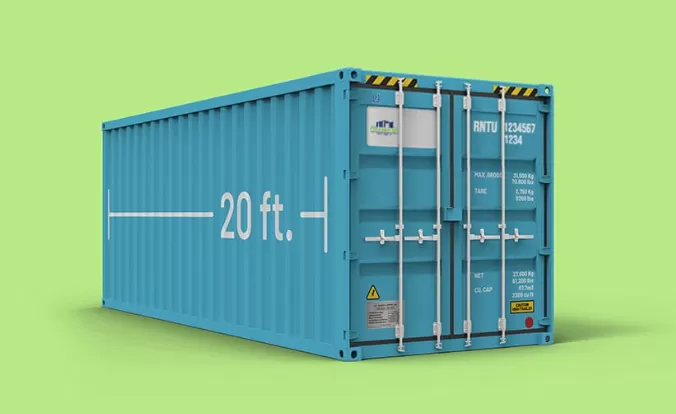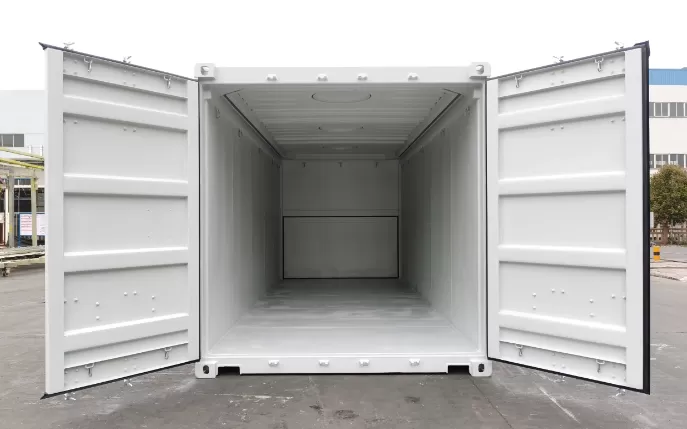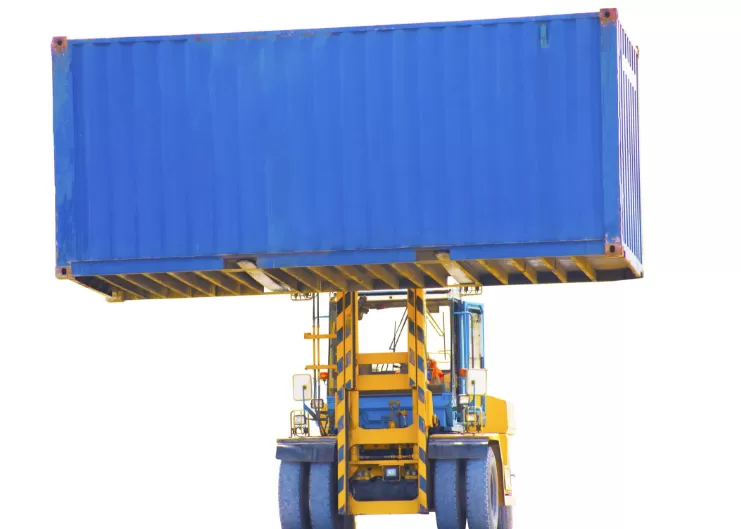So, how much does an empty 20 ft shipping container actually weigh? It sounds like a simple question, but the answer is more complex and far more critical than you might think. Getting it right is essential for planning your shipment, avoiding costly fines, and ensuring safety. Whether you're new to shipping or a seasoned logistics professional, this definitive 2024 guide will give you the clear, authoritative answers you need.
The Short Answer: Standard 20ft Container Tare Weight
Let's cut straight to the chase and give you the number you're looking for.
A standard 20 ft dry van shipping container has an empty weight—officially called its tare weight—that typically falls between 2,200 and 2,400 kg (4,850 and 5,290 lbs).
In simple terms: That's the weight of the container itself, completely empty and ready to be packed.
Why is there a range and not one exact number?
Small differences between manufacturers, the specific grade of steel used, and minor design changes over the years all contribute to this variance. Any number within this range is considered normal. We'll explore the reasons for these differences in more detail below.
Understanding "Tare Weight" and Why It Matters
What Exactly Is "Tare Weight"?
Think of tare weight like the curb weight of a car. It's the total mass of the container itself when it's completely empty. This includes the weight of the steel structure, walls, floor, roof, doors, and every fixed component.
It does not include any of your cargo, packaging materials, or securing equipment inside.
Why Getting the Tare Weight Right is Crucial
Knowing the tare weight isn't just a technicality; it's a fundamental part of logistics planning:
Calculating Your Payload Capacity: This is the most important reason! Every container has a strict legal limit called the maximum gross weight (often 30,480 kg or 67,200 lbs). The weight of your cargo (payload) must be equal to or less than this total weight minus the tare weight.
The Formula:Maximum Payload = Maximum Gross Weight - Tare Weight
*Example: If your container's tare weight is 2,300 kg, your maximum cargo weight is 30,480 kg - 2,300 kg = 28,180 kg.*
Avoiding Costly Overweight Fines: If the combined weight of your cargo and the container itself exceeds the maximum gross weight, it is declared overweight. This leads to heavy penalties, delays, and the headache of having to unload part of your shipment.
Impact on Transport Costs: For those buying or leasing containers, the tare weight can affect the cost of transport and handling equipment required.
Ensuring Safety: Knowing the container's inherent weight is essential for safe stacking and is the foundation for any structural modifications (like converting a container into a building).
Detailed 20ft Container Weight & Dimensions Table
The tare weight varies significantly depending on the type of container. Here is a detailed specification table for different 20 ft container types.
| Container Type |
Internal Dimensions (Approx.) |
Tare Weight (Approx.) |
Payload Capacity (Approx.) |
Max Gross Weight |
| 20' Standard Dry Van |
5.9 m x 2.35m x 2.39m
(33.1 CBM / 1,170 CuFT) |
2,200 - 2,400 kg
(4,850 - 5,290 lbs) |
27,600 - 28,280 kg
(60,850 - 62,350 lbs) |
30,480 kg
(67,200 lbs) |
| 20' High-Cube Dry Van |
5.9 m x 2.35m x 2.69m
(37.4 CBM / 1,320 CuFT) |
2,250 - 2,450 kg
(4,960 - 5,400 lbs) |
27,430 - 28,230 kg
(60,470 - 62,240 lbs) |
30,480 kg
(67,200 lbs) |
| 20' Reefer Container |
5.44 m x 2.29m x 2.27m
(28.3 CBM / 1,000 CuFT) |
3,100 - 3,500 kg
(6,830 - 7,720 lbs) |
26,980 - 27,380 kg
(59,480 - 60,370 lbs) |
30,480 kg
(67,200 lbs) |
| 20' Open-Top Container |
5.89 m x 2.35m x 2.35m
(32.6 CBM / 1,152 CuFT) |
2,300 - 2,500 kg
(5,070 - 5,510 lbs) |
27,980 - 28,180 kg
(61,690 - 62,130 lbs) |
30,480 kg
(67,200 lbs) |
Note: The figures above are averages for common specifications. Always confirm the data on the actual container's plate.
Key Factors That Influence a Container's Empty Weight
Since the tare weight isn't a fixed number, what causes it to change? Here are the four main factors:
Manufacturer & Build Standards: Different container manufacturing companies use slightly different steel specs, frame designs, and construction standards, leading to small weight variations.
Materials & Design Iterations: Newer containers might use higher-strength, lighter-weight steel, allowing them to be just as strong while weighing slightly less than older models.
Age & Wear: A used container that's been in service for years may have undergone repairs—like a partial floor replacement or repainting—that can slightly alter its original weight.
Special Features & Equipment: This is the big one. For example, a reefer (refrigerated) container is significantly heavier due to the built-in refrigeration unit and thick insulation, often adding 900-1000 kg to the tare weight.
Practical Application: How to Find the Exact Weight and Calculate Your Load
Now for the practical part: how do you find the exact weight for your specific container?
Step 1: Find the Authoritative Source
The answer is on the container itself. Look for the CSC (Container Safety Convention) plate on the right door of every container. This metal plate clearly states all the container's key data, including its TARE WEIGHT.
This is the most accurate and authoritative source. Always use this number.
Step 2: Do the Math
Let's say the TARE weight on your container is 2,350 kg and the MAX GROSS weight is 30,480 kg.
Your maximum cargo weight (payload) would be:
30,480 kg - 2,350 kg = 28,130 kg
Pro Tip: Before loading, always double-check the tare weight of your assigned container with your freight forwarder or shipping line to avoid any surprises.
Need help calculating complex cargo weight and shipping costs?
Try our Smart Freight Calculator for an instant, accurate estimate!
Frequently Asked Questions (FAQ)
Q1: What is the difference between tare weight and gross weight?
A: Think of it like this: Tare weight is the weight of the empty container itself. Gross weight is the absolute maximum allowed weight of the fully loaded container (tare weight + cargo weight). The payload is the difference between them—it's the actual weight of goods you can safely load inside.
Q2: How much does a 20 ft container weigh when it's full?
A: A fully loaded 20 ft container can legally weigh up to its maximum gross weight of 30,480 kg (67,200 lbs). Its actual weight when full will be its tare weight (e.g., 2,300 kg) plus the actual weight of your cargo.
Q3: How many tons is a 20 ft container?
A: The tare weight of a standard 20 ft container is typically between 2.2 and 2.4 metric tons. (Since 1 metric ton = 1,000 kg, a 2,300 kg container weighs 2.3 tons).
Q4: Where exactly do I find the official weight of my container?
A: Look for the metal CSC plate mounted on the right door of the container. The "TARE" weight listed there is the official, certified empty weight for that specific unit. Always use this number for accurate calculations.
Q5: Does a 20 ft high cube container weigh more than a standard one?
A: Yes, slightly. Due to the extra steel in its taller structure, a high cube container's tare weight is usually 50-100 kg (110-220 lbs) more than a standard height container.
Q6: Why is a reefer (refrigerated) container so much heavier?
A: Reefers are heavier because they contain a large, integrated refrigeration unit and thick insulation panels within the walls and floor to protect temperature-sensitive cargo. This added equipment can increase the tare weight by 900 kg (2,000 lbs) or more.
Q7: Who is responsible if my container is overweight?
A: Ultimately, the shipper (the person or company loading the cargo) is legally responsible for ensuring the container does not exceed its maximum gross weight. Your freight forwarder can advise you, but the final obligation is yours.
Q8: What are the consequences of shipping an overweight container?
A: The consequences are severe and costly. They can include:
Heavy fines from the carrier and port authorities.
Delays as you are forced to offload cargo to meet weight limits.
Safety risks during handling and transport, including damage to equipment.
In extreme cases, refusal of loading onto the ship.
Q9: Can I reduce the tare weight of a container?
A: Generally, no. The structure is integral to its strength and safety certification. Removing any part is dangerous and illegal for shipping purposes. The tare weight is considered a fixed value for logistics planning.
Q10: How does the container's weight affect shipping costs?
A: For LCL (Less than Container Load) shipments, your cost is based on the volume or weight of your cargo—whichever is greater. The container's tare weight doesn't directly affect this.
For FCL (Full Container Load) shipments, while you pay a flat rate for the container, the tare weight is a key factor for the carrier's overall equipment balancing and fuel calculations, which are factored into their pricing models. Furthermore, if you are paying to transport an empty container (e.g., for relocation), the tare weight directly impacts the freight cost.
Ready to Ship or Buy with Confidence?
You're now equipped with expert knowledge about container tare weight. Applying this knowledge accurately is the key to safe, compliant, and cost-effective shipping.
But knowledge is only the first step. The right partner ensures your plans are executed flawlessly.
At [Your International Logistics Company Name], we know that details make the difference. Every container we provide comes with clear, accurate data, and our logistics experts will help you plan your shipment with precision, steering you clear of potential pitfalls.
🚢 Get a Accurate Quote & Custom Solution
Click here to contact our expert team for a tailored logistics plan
*Your trusted global logistics partner for over 10 years, with a service network covering 100+ countries worldwide.*

 EN
EN
 FR
FR
 ES
ES
 JA
JA
 PT
PT
 RU
RU
 AR
AR







